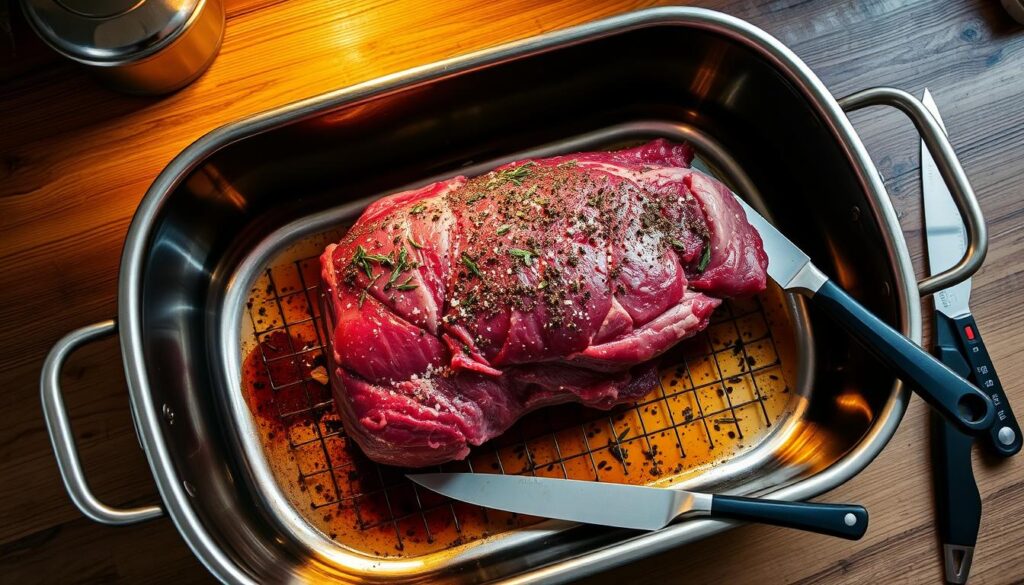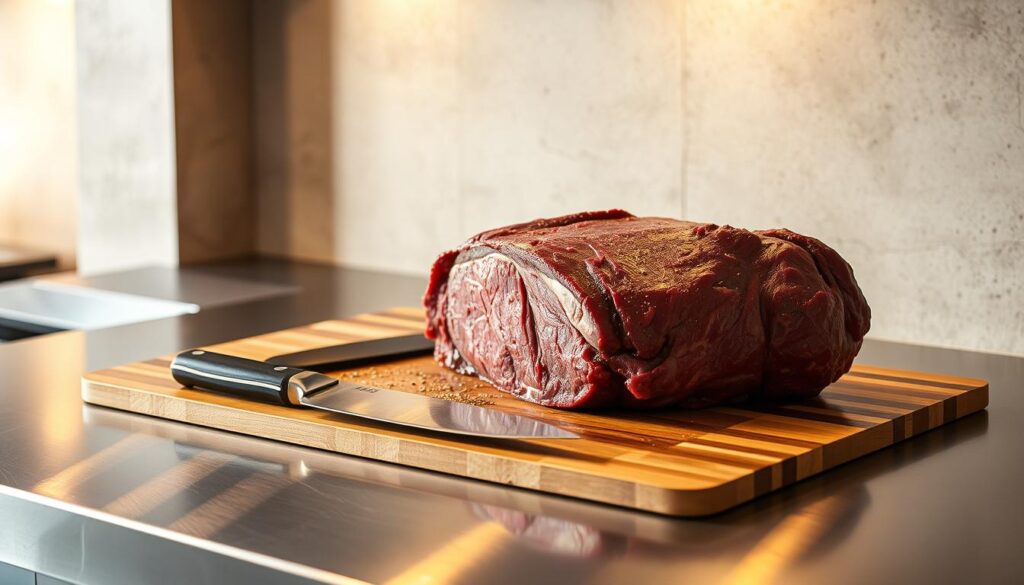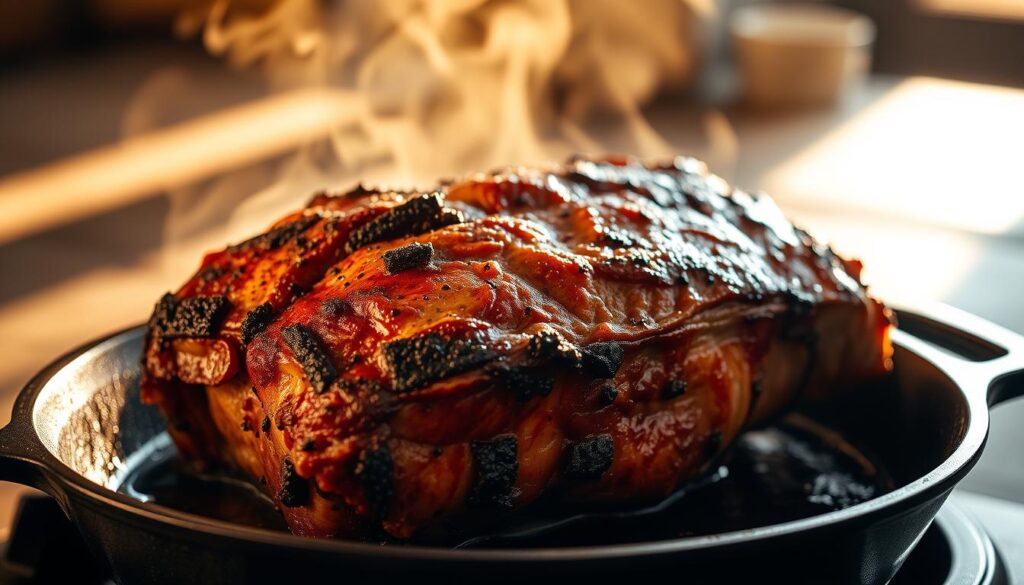I remember my first try at cooking a beef bottom round roast. It was tough, dry, and a letdown. This failure started my quest to learn how to make this cut delicious.
Cooking a beef bottom round roast is more than just throwing meat in a pan. It needs skill, patience, and knowledge. This cut comes from the cow’s lower rump and needs special care to be tender and tasty.
If you want to impress your family or improve your cooking, this guide is for you. It will show you seven easy steps to make a beef roast that’s incredibly tasty.
The secret to a great beef bottom round roast is knowing how to handle it. Unlike tender cuts, this roast needs special techniques to be soft and juicy.
Ready to turn a simple beef roast into a memorable meal? Let’s explore how to make the perfect bottom round roast!
Understanding Beef Bottom Round Roast
Preparing a delicious beef round roast recipe starts with knowing your meat. The bottom round roast is lean and muscular.It requires special preparation to achieve tenderness.
The round section of beef, including bottom round, is in the cow’s hindquarter. This area gives leaner cuts. They need careful cooking for the best flavor and tenderness.
What Makes This Cut Special
Rump roast beef is special for several reasons:
- It’s very lean with little fat marbling
- It’s a cost-effective choice compared to more expensive cuts.
- It’s full of protein and important nutrients
- It’s perfect for those watching their health
Best Cooking Methods for Bottom Round
To make your beef round roast tender and tasty, try these cooking methods:
- Slow roasting at low temperatures
- Braising in tasty liquids
- Marinating to tenderize the meat
- Slicing against the grain after cooking
Nutritional Benefits and Value
Bottom round roast is a nutritional powerhouse. It’s a lean protein with iron, zinc, and B vitamins. Its low fat makes it great for those watching calories but still wanting a hearty meat dish.
Essential Equipment and Ingredients for Perfect Roasting
To make an amazing oven roasted beef, you need more than just a good beef chuck roast. The right tools and ingredients can make your cooking better and your dish taste like it’s from a restaurant.

Kitchen Tools You’ll Need
Good roasting needs the right equipment. Your essential tools should include:
- Digital meat thermometer for precise temperature tracking
- Large roasting pan with rack
- Sharp carving knife
- Aluminum foil for covering and resting
- Kitchen twine for trussing the roast
Seasonings and Marinades
Make your beef chuck roast taste better with the right seasoning. A classic mix might be:
- Kosher salt for deep flavor penetration
- Coarse black pepper
- Dried herbs like thyme and rosemary
- Garlic powder
- Olive oil for moisture and browning
Additional Ingredients for Enhanced Flavor
Try these ingredients to add more flavor to your oven roasted beef:
- Beef broth for basting
- Fresh herbs for aromatics
- Worcestershire sauce
- Dijon mustard
With the right tools and ingredients, you’ll make a perfectly roasted beef chuck roast. It will be tender, flavorful, and sure to impress.
Preparing Your Beef Bottom Round Roast
Getting your beef roast ready for cooking is key. The secret to a delicious pot roast beef starts before it goes in the oven. You aim to turn an ordinary cut into a mouthwatering meal that will wow everyone at the table.

Start by taking your beef roast out of the fridge about 30 minutes before cooking. This step is crucial. It lets the meat get to room temperature, ensuring even cooking and tenderness. Cold meat can lead to uneven roasting and less juicy results.
- Remove beef roast from refrigerator
- Let meat sit at room temperature for 30 minutes
- Pat the meat dry with paper towels
- Inspect for any excess fat or silver skin
While your beef roast rests, mix up a flavorful seasoning blend. For this pot roast beef, you’ll want a robust mix of herbs and spices. Think about combining:
- 2 tablespoons fresh rosemary
- 2 tablespoons fresh thyme
- 1 tablespoon fresh sage
- 3 minced garlic cloves
- 1 ½ tablespoons coarse salt
- 1/3 cup olive oil
Pro tip: Gently massage the herb mixture into the meat, ensuring complete coverage for maximum flavor absorption. This method will help your beef roast develop a rich, aromatic crust during cooking.
The Science Behind Temperature and Timing
Mastering the art of cooking a slow cooker beef roast or braised beef roast requires understanding the critical relationship between temperature and timing. Your roast’s ultimate tenderness and flavor depend on precise heat management and careful monitoring.
Cooking a perfect roast isn’t just about following a recipe—it’s about understanding the science behind meat preparation. Temperature plays a crucial role in transforming tough muscle fibers into melt-in-your-mouth deliciousness.
Optimal Cooking Temperatures
When preparing your slow cooker beef roast, keep these temperature guidelines in mind:
- Rare: 125°F (52°C)
- Medium Rare: 135°F (57°C)
- Medium: 145°F (63°C)
- Medium Well: 150°F (66°C)
- Well Done: 160°F (71°C)
Internal Temperature Guide
Tracking your braised beef roast’s internal temperature ensures perfect doneness. Use a reliable meat thermometer inserted into the thickest part of the roast, avoiding fat or bone.
Resting Period Importance
After cooking, let your roast rest for 15-30 minutes. This critical step allows juices to redistribute, ensuring each slice remains tender and flavorful. During resting, the internal temperature will rise an additional 5-8°F, completing the cooking process.
Pro tip: Patience during the resting period is key to achieving a perfectly juicy roast.
Mastering the Searing Process

Searing your beef roast is key to making it a culinary masterpiece. It creates a golden-brown crust that keeps flavors locked in. This crust adds incredible depth to the taste. The secret is understanding the Maillard reaction, a chemical process that browns meat and enhances flavors.
To get the perfect sear, follow these steps:
- Select a heavy-bottomed pan with excellent heat retention
- Choose high smoke point oils like avocado or grapeseed
- Pat the beef roast completely dry before searing
- Preheat your pan to at least 375°F
Salting your beef roast at the right time is important. Pro tip: Salt your roast and let it rest uncovered in the fridge overnight. This helps remove moisture, leading to a crisp crust.
Temperature control is key during searing. Flip your beef roast every 1-2 minutes for an even crust. Use a digital meat thermometer to check the internal temperature. For medium-rare, aim for 130-135°F.
Remember, a perfect sear is about patience and precision – not rushed cooking!
Your goal is to create a delicious exterior that seals in juices. A well-seared beef roast turns into a dish that will wow food lovers.
Low and Slow Cooking Method
Learning the low and slow cooking method makes your beef sirloin tip roast tender. It breaks down tough tissues, making the roast melt in your mouth. This technique is sure to wow any food lover.
The key to great low and slow cooking is knowing the right temperature and time. Your beef roast needs patience to become tender. Here’s what you need to know:
- Cook at 200-300 degrees F
- Target internal temperature of 200-210 degrees F
- Cooking time: approximately 30 minutes per pound
- Total cooking duration: 8-10 hours for maximum tenderness
Moisture Control Techniques
Keeping moisture in is key when cooking your beef sirloin tip roast. Cover the roast partially to trap steam and keep it juicy. Use a tight lid or aluminum foil to seal in moisture.
Basting and Monitoring
Basting helps spread flavors and keeps the meat moist. Every 1-2 hours, spoon some cooking liquid over the roast. Use a meat thermometer to check the internal temperature. This ensures the roast is cooked just right.
Allow your roast to rest for 15–20 minutes after cooking for the best flavor and juiciness.
This allows juices to spread, making the roast even more flavorful.
Creating Rich Pan Gravy From Drippings
Turning your pot roast beef drippings into a rich gravy makes your beef chuck roast special. It’s all about catching those tasty pan juices and turning them into a smooth sauce. This sauce will enhance your perfectly cooked meat.
Start by straining the roasting pan drippings through a fine-mesh sieve. This removes any solid pieces. You’ll need about 2-3 tablespoons of fat from the drippings for a perfect roux.
Ingredients for Perfect Gravy
- 3 tablespoons butter
- 3-4 tablespoons all-purpose flour
- 4 cups beef broth
- 3 teaspoons onion powder
- 1 teaspoon garlic powder
To make a smooth gravy, mix flour with the reserved fat to make a roux. Cook it for about 2 minutes until it’s light golden. Then, slowly add your beef broth while whisking constantly. This prevents lumps.
Allow the gravy to simmer for 2-3 minutes until it thickens. Season with salt and pepper to taste. If it’s too thin, mix 4 tablespoons of cornstarch with 1/3 cup water. Gradually incorporate this into the simmering gravy.
Nutritional Highlights
Your homemade gravy has about 55-65 calories per 1/4 cup. It’s rich in carbs, protein, and minerals.
Pro chefs say a great gravy can turn a simple pot roast beef into a memorable meal. Your beef chuck roast deserves this rich, flavorful sauce.
Storage and Leftover Management
After cooking your beef roast, it’s important to store it right. This keeps its flavor and makes it safe to eat. You can store your rump roast beef in the fridge for 3 to 4 days in an airtight container. Freezing sliced beef roast for up to 3 months is also an option, so you can enjoy it later.
When you reheat your leftover beef roast, do it gently. This stops the meat from drying out. Use the microwave on low or warm it in a skillet on low heat. This way, your beef roast stays tender and juicy, just like when it was first cooked.
Proper Storage Methods
Let your beef roast cool down to room temperature before storing. Wrap it tightly in plastic wrap or foil, then put it in a sealed container. For freezing, use freezer-safe bags and remove air to avoid freezer burn and keep the quality of your rump roast beef.
Creative Leftover Recipes
Turn your leftover beef roast into tasty dishes like sandwiches, salads, or stir-fries. Slice it thinly for beef stroganoff, chop it for nachos, or shred it for sliders. This way, you make new meals, reduce waste, and show off your cooking skills.
FAQ
What is a beef bottom round roast?
A beef bottom round roast is a lean cut from the cow’s rear leg. It’s tough but can be tenderized with the right cooking. Low and slow cooking breaks down the fibers, making it moist and flavorful.
What are the best cooking methods for bottom round roast?
The top methods for cooking bottom round roast are slow roasting, braising, and pot roasting. These methods tenderize the meat by breaking down tough tissues. Cooking at a low temperature for a long time works best. Braising in liquid or using a slow cooker keeps the meat moist.
How long should I cook a bottom round roast?
Cooking time varies based on the roast’s weight. Cook at 325°F for approximately 20 to 25 minutes per pound. For medium-rare, the internal temperature should be 135°F. Always use a meat thermometer to ensure your food is cooked perfectly and not overdone.
Should I marinate a bottom round roast?
Marinating is highly recommended for bottom round roast. It tenderizes the meat and adds flavor. Use acidic marinades like vinegar or citrus juice. Marinate for at least 4-8 hours or overnight for the best results.
What seasonings work best with bottom round roast?
Robust seasonings like garlic powder, thyme, and rosemary work well. Oregano and paprika can also enhance the flavor. Adding Worcestershire sauce or mustard can add depth to your seasoning mix.
How do I prevent my bottom round roast from becoming dry?
To avoid dryness, use low-temperature cooking and avoid overcooking. Techniques like basting or cooking in liquid help keep it moist. Letting the roast rest for 10-15 minutes after cooking helps keep it juicy.
Can I slice bottom round roast thin for sandwiches?
Yes, bottom round roast is great for sandwiches when sliced thinly. Let it cool completely before slicing. Use a sharp knife or meat slicer to get even slices. Chilling the meat slightly helps with cleaner cuts.
What are some recommended side dishes for bottom round roast?
Classic side dishes include roasted vegetables, mashed potatoes, and creamy polenta. Root vegetables like carrots and parsnips are also good. Serve with a rich pan gravy for a complete meal.